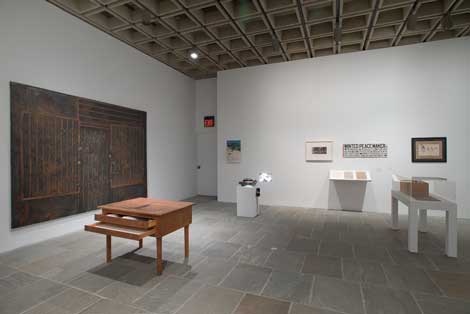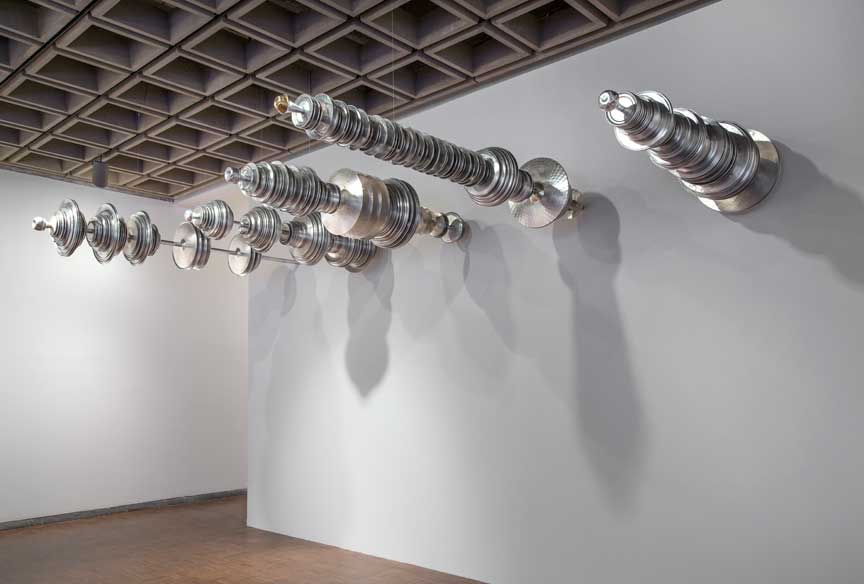Except for those closely involved with it, I can’t imagine many people actually look forward to the Whitney Biennial. It feels like one of those unavoidable social obligations you reluctantly drag yourself to, but once you’re there you begin—in part because of your diminished expectations—to actually have a good time. After you go home it’s hard to remember everyone you saw and what they said, but it was all pleasantly diverting, and no one seriously pissed you off.
Well in advance of “Whitney Biennial 2014,” the museum’s publicity department was trumpeting that the exhibition has (a) three autonomous curators, all of whom are (b) out-of-towners, and that two of them are (c) also artists. The catalog insists that the most seemingly radical of these ideas—the exhibition consisting of three independently organized iterations—is less a break with tradition than a logical extension of the shape of curatorial assignments past. And a reworking of the old routine is indeed fitting for this, the final biennial being staged in the ever-amazing Marcel Breuer building before the museum decamps to its downtown riverfront location some time next year.
Early reports of this year’s Whitney Biennial indicated that the 4th floor, the work of artist/writer/curator/educator Michelle Grabner, was the standout, and as of this writing, that sentiment has emerged as the consensus. If one overlooks the fact that the Whitney’s installation of those works fell victim to the overcrowding that lately plagues art exhibitions almost everywhere, Grabner’s selections provided some intriguing moments of true delight.
But the same could be found on the 3rd floor, organized by Stuart Comer (until recently the curator of film at Tate Modern, and now at MoMA) and on the 2nd floor, assembled by Anthony Elms (artist, associate curator at the ICA in Philly, and editor at the art book publisher WhiteWalls). In fact, “WB 2014” is one of the liveliest exhibitions in memory, grounded in an invigorating dose of traditional painting, drawing, sculpture and photography while looping in some pretty hot conceptual, media-based, and participatory contemporary art—much of it in the form of printed matter.
Los Angelenos, your local talent is represented in all its intergenerational, object-based glory, notably by Sterling Ruby’s hulking ceramic vessels shaped like giant ashtrays and littered with casualties of the kiln; Stephen Berens’ dense, brooding views of Rome, made with multiple exposures; and Rebecca Morris’ large and beguiling, supremely odd canvases, which somehow defy the quick read they seem at first to promise—in the artist’s immortal words: “Abstraction never left, motherfuckers.”
In a memorable instance of curatorial huffing and puffing, Comer recombines slick chromogenic prints from the “Relationships” series by Zackary Drucker and Rhys Ernst, of pretty-vacant androgynes; ping-ponging, color-coded grids notating performance cues by the late Channa Horwitz; and Morgan Fisher’s dour, 9-foot-high structure based on the spaces of three nested rooms, made of unpainted drywall board. Discord can be productive, certainly, but one’s impulse is to seek a throughline joining these dissimilar works: time racing, time marked, time standing still?
Speaking of time and Horwitz, mention should be made of the preponderance of figures who speak from beyond the grave: from the Pictures Generation, artists Sarah Charlesworth and Gretchen Bender; painter Tony Greene (in a tribute marshaled by Catherine Opie and Richard Hawkins); photographer Alan Sekula, represented by a few uninteresting pocket-sized notebooks; the polymath activist Malachi Ritscher, presented by Public Collectors, a Chicago-based project; the critic Gregory Battcock, in a sampling of documents rescued from oblivion by Joseph Grigely; David Foster Wallace, remembered in a display of notes for The Pale King, left unfinished by his suicide; and artist/musician/composer Terry Adkins, whose elegant, exuberant Aviarium (2014)—five steel poles extending horizontally from the wall overhead, each outfitted with a unique sequence of metal cymbals—provides a visual highlight of the show and, just weeks after Adkin’s unexpected death at the age of 60, one of its saddest moments as well.

Afterlife: a constellation, 2014, by Julie Ault, installation view. Whitney Biennial 2014, Whitney Museum of American Art, New York, Photograph by Bill Orcutt
Yet the party rolls along: I dig that crazy vitrine of corkscrew-carved wooden pencils by Peter Schuyff, better known for his painted Opstractions from the 1980s; kooky-yet-diffident sculpture/photo hybrids by Chicagoan Carol Jackson that feature ornate contours, repellent surfaces and ink-jet prints; and Jennifer Bornstein’s unexpectedly affecting, four-and-a-half-minute silent video of two nude, lusciously pink young ladies doing some kind of slow-mo contact improv in a surrealistically featureless landscape.
Were it not for the need to press on, it would have been rewarding to linger over the 16-minute excerpt from Gilles Deleuze From A to Z, a video of an interview with the great thinker by Claire Parnet that is presented in the Semiotext(e) exhibit, or the documents and artifacts from the estates of David Wojnarowicz and Martin Wong, lent by the Fales Library of NYU for Julie Ault’s evocation of the old East Village scene, Afterlife: a constellation. But work requiring prolonged focus doesn’t do very well here, where the overwhelming majority of viewers (including your intrepid correspondent) move briskly through the show in order to see as much as possible before becoming physically and visually exhausted.
My bad: I approached this Biennial like one would the concurrent Armory Show, and I suppose that might suggest that I have no sense of occasion. But this issue of spectatorship—the matter of how to be a responsible viewer who gives difficult, time-consuming work a chance while still responding emotively to the stuff that just grabs you—rests on the matter of the pacing of exhibitions, and that, it seems to me, is linked closely to museum design. Perhaps most of all, the Whitney’s relocation downtown has me looking forward to seeing how Renzo Piano and the rest of the design team provide for the institutionally under-recognized distinction between art that comes at you all at once and art with a long, involved story to tell.
Whitney Biennial 2014 runs through May 25, info at whitney.org



